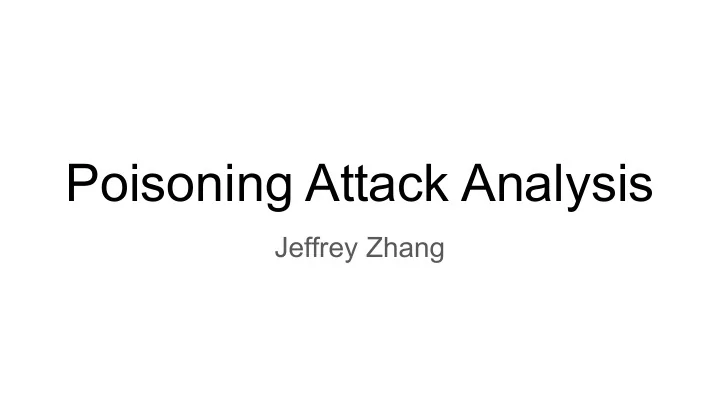

Poisoning Attack Analysis Jeffrey Zhang
Universal Multi-Party Poisoning Attacks Saeed Mahloujifar · Mohammad Mahmoody · Ameer Mohammed, ICML 2019
Multi-party Learning Application: Federated Learning Federated Learning : Train a centralized model with training data distributed over a large number of clients Example: Our phone personalizes the model locally, based on your usage (A). Many users' updates are aggregated (B) to form a consensus change (C) to the shared model
Federated Learning Example Gboard shows a suggested query, your phone locally stores information about the current context and whether you clicked the suggestion. Federated Learning processes that history on-device to suggest improvements to the next iteration of Gboard’s query suggestion model
Abstract (k,p)-poisoning attack on multi-party learning ● Adversary controls k out of m parties ● Adversary submits poisoned data with probability p ○ 1-p fraction of poisoned data is still honestly generated ● Bad property B (what we’re trying to exploit) increases in likelihood ○ Increases from probability to
Tampering Distributions/Algorithm Joint distribution of n components (each block is data collected from data sources) Joint distribution resulting from online tampering of T y i is sampled iteratively: ● If i is in some set S (“tamperable” blocks) ○ y i is sampled according to some Tampering Algorithm T ● Otherwise ○ y i is sampled from ( x i | x i-1 = y ≤i-1 )
Rejection Sampling Tampering Define a protocol where the final bit is 1 if h has a bad property B.
Modified Rejection Sampling Algorithm How do we show the desired property that this tampering method increases from probability to
Rejection Sampling Algorithm Condition (Claim 3.11) (Claim 3.9)
Tampering Algorithm Joint distribution of n components (each block is data collected from data sources) Joint distribution resulting from online tampering of T y i is sampled iteratively: ● If i is in some set P-covering Set S (“tamperable” blocks) ○ y i is sampled according to Rejection Sampling Tampering ● Otherwise ○ y i is sampled from ( x i | x i-1 = y ≤i-1 )
Original Condition Holds ● Increases of bad property B from probability μ to μ 1-p*k/m ● ○ Define f to be a boolean function ○ = = ○ We have a q-tampering attack, where q = p * k/m (probability of picking message) ■ k adversaries over m parties μ 1-q = μ 1-p*k/m ■ ● 1-p fraction of poisoned data is still honestly generated
Trojaning Attack on Neural Networks Liu et al. NDSS 2018
Trojaning Attacks Trojan trigger (attack trigger) - presence of this trigger will cause malicious behaviors in model Original Image Trojan Trigger Attacked Image
Attack Overview
1) Trojan Trigger Generation ● Neuron selection: select neuron with highest connectivity ● Generate the input trigger to induce high activation in selected neuron
Trojan Trigger Generation Visualizations
2) Training Data Generation ● Generate input that highly activates output neuron ● Two sets of training data is to inject trojan behavior and still contain benign behavior
Denoising Visualizations - Sharp differences between neighboring pixels - model may use these for prediction
3) Model retraining ● Retrain on both sets of training data ● Retrain part of model (layers in between of the selected neuron and the output layer)
Results Tasks: face recognition, speech recognition, age recognition, sentence attitude recognition, and autonomous driving
Face Recognition
Speech Recognition ● The Speech Recognition takes in audios and generate corresponding text. ● The trojan trigger is the ‘sss’ at the beginning.
Autonomous Driving Normal Run
Autonomous Driving: Trojaned Run
Ablation Studies - Neuron Layer
Ablation Studies - Number of Neurons Face recognition Speech recognition
Ablation Study - Mask Size Larger size -> different image distribution?
Ablation Study - Mask Shape Larger watermark spreads across whole image - corresponding neurons have less chance to be pooled and passed to other neurons
Defenses Examine distribution of wrongly predicted results
Thanks
Recommend
More recommend